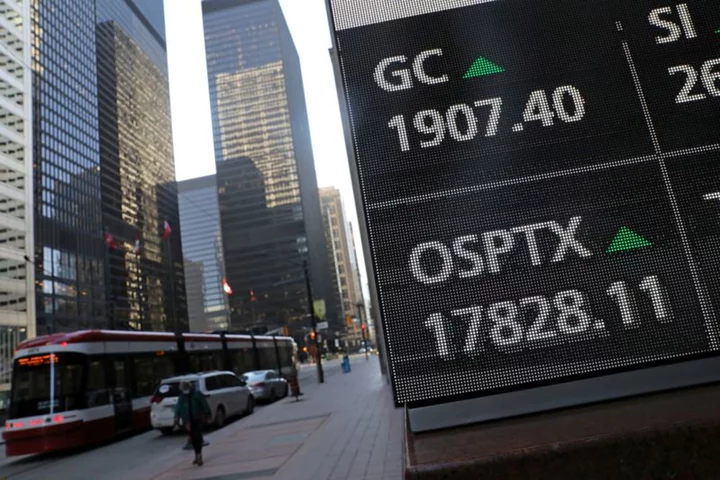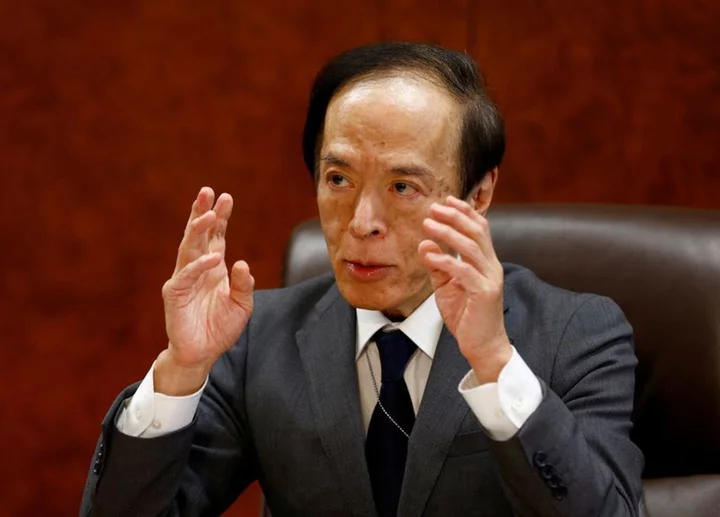By Davide Barbuscia and Carolina Mandl
NEW YORK Recent shifts in the U.S. Treasury yield curve may indicate that market optimism around the economy could wane, with some investors looking at Federal Reserve Chair Jerome Powell's speech at an economic symposium on Friday as a potential trigger for a correction or rapid unwind in positions.
The yield curve comparing two-year with 10-year yields has been inverted on a continued basis for over a year, a reliable sign of a looming recession, but it has steepened in recent weeks because 10-year yields have been rising while shorter-dated ones have remained flat.
The so-called "bear steepening" suggests that the market expects high interest rates to no longer hurt the economy, with investors extending their horizon for how long the Fed will maintain its restrictive policy stance.
The move has coincided with rising market expectations for a so-called soft landing for the economy - a scenario in which the Fed curbs inflation without causing a recession.
In line with that trend, hedge funds' bearish bets on long-term U.S. Treasuries have built up over several weeks, with net short positions in 10-year U.S. Treasuries futures at their highest levels since the beginning of July, according to Commodity Futures Trading Commission data from last week. That has led to the risk of an unwind, some market participants say.
"The problem with crowded trades is that it is a bit like 100 elephants trying to squeeze through one door," said Michael Harris, president of New York-based hedge fund Quest Partners, who sees the risk of the short bond position getting unwound. "It's not pretty."
Some analysts warn that rising yields could push up borrowing costs, causing the economic slowdown investors are now betting against.
"Repricing for higher rates amid an expectation of 'higher for longer' Fed policy is creating a tightening in financial conditions that could strain the economy and markets," said Gennadiy Goldberg, head of US Rates Strategy at TD Securities USA.
The key question is how much further bear steepening the market needs to see for "investors to become nervous," he added.
The 2/10 curve steepened to minus 78 basis points from minus 108 bps at the beginning of July, although it has flattened in the last few days.
Previous similar bear-steepening episodes have not lasted long, said Alfonso Peccatiello, chief executive of global macro investment strategy firm The Macro Compass who studied similar dynamics in 2018, 2007-2008 and 2000.
In 2018, for instance, the curve shifted to a bear-steepening dynamic as the economy appeared to hold up well despite the Fed's tightening. That lasted for about seven weeks, until early October 2018, when equities peaked before falling sharply over the following months.
Investors tend to become frustrated when largely anticipated recessions fail to materialize as the Fed approaches the end of its hiking campaigns, "so bond markets push the tightening aggressively down the curve right when the economy is slowing - a dangerous cocktail," Peccatiello said.
Several Wall Street banks have recently revised or pushed out their forecasts for a U.S. recession in light of surprisingly strong economic data. Risks remain, however, warned Jonathan Cohn, head of US Rates Desk Strategy at Nomura Securities International, including the pain for companies refinancing debt at higher rates and China's weakening growth.
"It's quite possible that capitulation on recession calls has happened too soon," he said.
Investors largely expect the Fed to have reached a peak in interest rates and to maintain them in the current 5.25%-5.5% range until it starts easing in the second quarter next year.
BEARISH BETS
Some investors are worried that Powell’s speech at the Fed's annual economic symposium in Jackson Hole, Wyoming, could trigger a short squeeze.
"If Powell doesn't come across as conveying the message that they will kind of stay at the top of the mountain for as long as they need, then the market goes in the opposite direction," Harris said. "That's where you have the risk that (that) short bond position gets unwound."
Harris said it could create a reversal like that seen in March, where the banking crisis caused yields to plunge and hurt hedge funds' short Treasury positions.
A softer message from Powell is possible, said Eoin Walsh, a partner and portfolio manager at TwentyFour Asset Management.
"Powell may feel he can hit pause on the message for further hikes and higher for longer, potentially allowing him the rare opportunity to be more market friendly this week," he said.
Conversely, a reaffirmation that the battle against inflation is far from over and that more tightening is needed to bring it down to the Fed's 2% goal could push short-term yields higher and ignite a rally in long-term bonds, as investors would see further hikes as accelerating an economic downturn, said Jim Cahn, chief investment officer at financial investment and advisory firm Wealth Enhancement Group.
"I think that (would) signal to the market that the Fed is willing to overshoot to the upside on rates," Cahn said.
Michael Edwards, deputy chief investment officer at multi-strategy hedge fund Weiss, said a very hawkish read from Powell would cause bear flattening, as the front end of the curve would come up, although he sees that as unlikely.
"The back end would come down relative to the front end because there'd be a higher probability of a recession in 2024," Edwards said. "It would be a pain trade for people."
(Reporting by Davide Barbuscia and Carolina Mandl; Editing by Michelle Price, Megan Davies and Mark Porter)









